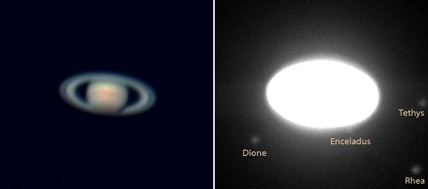
Saturn's moons are much fainter than the planet itself. A short exposure (left) captures only the planet and its rings, whereas an exposure long enough to record the moons (right) drastically overexposes Saturn. At the time these images were made, Saturn's brightest moon, Titan, was several ring diameters to the west (right) and outside the field.
Sky & Telescope photos by Richard Tresch Fienberg.
Saturn reaches opposition on the night of January 13–14, 2005, which is close to the time when the Cassini spacecraft's Huygens probe should touch down on Titan. At every opposition the Sun, Earth, and Saturn are nearly aligned in space, but this opposition is special. An observer at Saturn would literally see Earth transit the disk of the Sun — something that has not happened since 1990 and won't take place again until 2020.
While no one can be there to see the transit directly (and the Sun is too bright for Cassini to image), the near-perfect alignment gives Earth-based astronomers their only chance in many years to truly measure the "opposition effect" — a dramatic brightening expected to occur in the Saturnian system as the solar phase angle approaches zero. Measurements should reveal important clues to the surface composition of such moons as Tethys, Dione, Rhea, and Iapetus. (Mimas and Enceladus are probably too close to the rings to be considered reasonable targets.)
Anne Verbiscer (Department of Astronomy, University of Virginia) and Richard G. French (Department of Astronomy, Wellesley College) are coordinating a NASA-funded, worldwide campaign to measure the brightness of these moons as close as possible to the time of the alignment. Ten ground-based observatories and the Hubble Space Telescope are involved already, and they are seeking even wider participation.
"We ask advanced amateurs with CCD-equipped telescopes to observe this event," Verbiscer writes, "not only on the critical night of January 13, 2005, but for two nights on either side of opposition, weather permitting.
"I am most interested in obtaining visible-light (UBVRI) CCD images whose exposure times are long enough to get usable photometry of the brighter moons. With these long exposures Saturn and its rings will be saturated, so we are not looking for 'pretty' CCD images of the planet and rings. Almost any size telescope will be sufficient, but the image scale should be such that a point source is recorded across several pixels for adequate sampling. Scattered light from Saturn and its rings will be the most significant complication, so a telescope with clean optics, few elements, and minimal diffraction will produce the best results.
"Since good photometry is our goal, multiple exposure times are needed to make sure that each satellite, in turn, is not saturated and not underexposed. At each exposure time several images should be taken, both to improve statistics and to protect against contamination from cosmic rays. Observations should alternate between the Saturn system and a nearby calibration field defined by our project."
Those wishing to participate can find detailed instructions here.
 0
0
Comments
You must be logged in to post a comment.